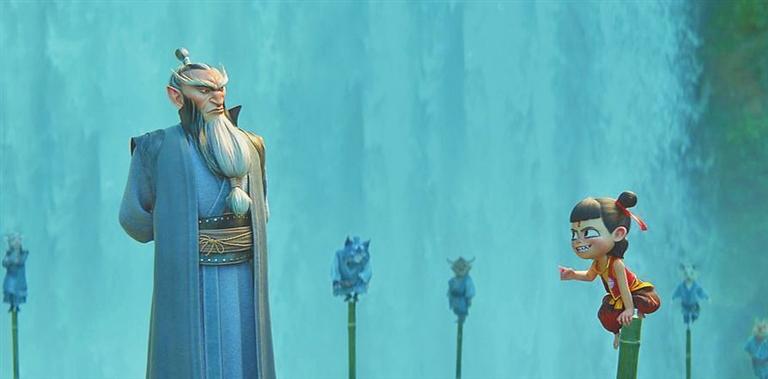
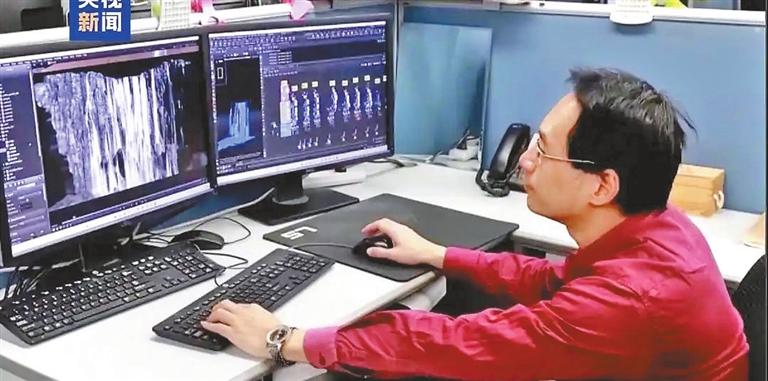
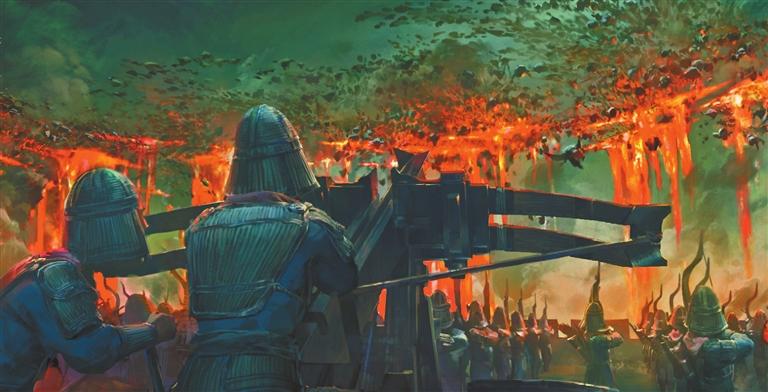
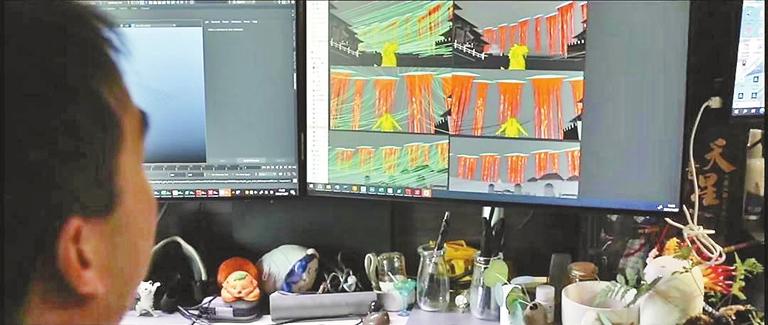
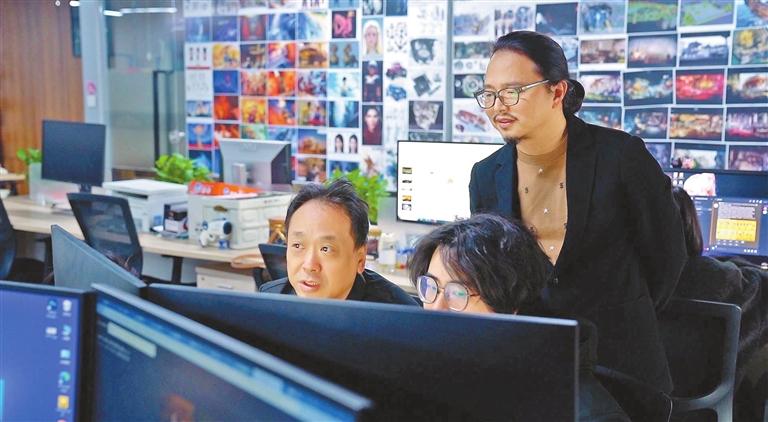
Wei Jie claudiamente@hotmail.com THE animated film “Ne Zha 2” has set new box office records again, with revenue exceeding 14.16 billion yuan (US$2 billion) by Saturday morning and becoming the first Asian film to enter the top seven on the global box office chart. The film has also become the highest-grossing animated film in the world. The phenomenal success of “Ne Zha 2,” inspired by the Chinese mythological tale of Ne Zha, a legendary boy with extraordinary powers, is partly attributed to its jaw-dropping special effects. Many viewers said they were particularly surprised by the advancements in domestic visual effects showcased in the animated movie, noting that the strong visuals gave them a heightened aesthetic experience. “I haven’t had the time to watch ‘Ne Zha 2’ yet, but I have seen some short videos that showcase the film’s visual effects,” said Shelly Wan Min, a Chinese American animator based in California. “I have to say that the visual effects showcased in the movie are truly stunning.” Wan, who previously worked for Pixar for years after graduating from college with a degree in animation production, was involved in a few projects. She was responsible for character design, including the 2001 animated film “Monsters, Inc.” Wan had worked for a Chinese animation company a decade ago, participating in the production of “Wish Dragon,” released in 2020, before relocating back to the United States. The five-year production process of “Ne Zha 2” involved more than 4,000 dedicated animators working on 1,948 special effects shots that integrated technical innovation with artistic expression. According to the end-of-movie credits, some 138 Chinese animation companies contributed to the movie’s production. Involvement in 'Ne Zha' From the awe-inspiring opening scene of Ao Run unleashing the Sky Splitting Claw to the epic battles featuring earth-shattering effects, and from Ne Zha’s Red Armillary Sash to Ao Bing commanding the icy Crystal Dragons, the meticulous craftsmanship of Shenzhen Rock Visual Effects Technology Co.’s visual effects team shines through in over 1,900 special effects shots. As the primary visual effects production team for the “Ne Zha” film series, the Longgang District-based company played a significant role in the making of the first and second installments. The main creative members of Rock have been active in the film production industry since the company was established in 2004, and they are among the earliest Chinese visual effects producers to establish a computer graphics research and development company following Hollywood production standards. “The visual effects shots in ‘Ne Zha 2’ are three to five times more difficult than that of ‘Ne Zha 1’ because the second film was made to adapt to IMAX screens, demanding extra attention to detail,” said Nie Huajun, a founder of Rock. For instance, the special effects for the Sky Splitting Claw involved creating multiple layers of magma flows with different materials and speeds — a complex shot that needed refining dozens of times, he said. According to Nie, the difficulty of film visual effects are usually categorized into levels S, A, B, C, and D. “The iconic Fire Lotus scene from the first movie of the ‘Ne Zha’ series is now considered a minor scene in comparison to the second film, barely ranking at level B,” he said. “Ne Zha 1,” also directed by Jiao Zi, was released in July 2019. In “Ne Zha 2,” details like trembling lotus leaves, cascading water ripples, roaring waterfall flows, and dynamic debris effects required meticulous work from the Rock team. They had to ensure that each key frame provided a visually stunning and logically coherent experience for viewers, which required countless experiments and revisions. The fight scenes between Shen Zhengdao and Ne Zha by the waterfall in the deep mountain forest are another highlight of the film. “It’s really shocking, to be fair,” said Lin Xin, who runs an advertising company in Shenzhen. Lin watched the film again Feb. 23 with his fifth-grade son at a cinema in Nanshan’s Houhai area. He noted that the flowing water of the waterfall looked incredibly real and that the details of the surrounding dense forest added a strong sense of pressure to the overall atmosphere of this scene. The smooth fight choreography, along with the backdrop of the waterfall and the dense mountain forest, took Shenzhen Huaqiang Fantawild Culture Technology Group Co.’s visual team three months to achieve. Wang Weiwei, team leader of the Fantawild special effects department, shared that his team had specifically developed an automated waterfall creation program to meet the stringent accuracy standards for the shots. “The scale of the waterfall is massive, and the intricate movements of the water demanded innovative solutions,” said Wang. The program his team developed performed calculations of water flow, which were distributed over multiple computers. They built a rendering cluster consisting of 50 high-performance workstations for batch processing, with each frame rendered for 32 hours. “The entire rendering process lasted 15 days,” Wang said. Rendering is a crucial step in film production, as it directly determines the visual effects presented in the final product. The stunning ocean battle scenes and the dynamic magical effects of Ne Zha, among other sequences in the film, were completed by Shenzhen Rayvision Technology Co. Ltd. According to the company, each frame in a grand scene like the Chentangguan battle, which features rich detail with numerous elements like flames, sea waves, and spell effects, would take several hours or even days to render using traditional methods. The special effects team at Rayvision utilized the company’s cloud-based rendering platform — Renderbus — for simultaneous processing, splitting the rendering tasks into smaller ones and distributing them across cloud servers. Renderbus significantly boosted rendering speed and efficiency, enabling the animators to render numerous complex scenes within a short timeframe, thus reducing production time. Contributions to other blockbusters In addition to “Ne Zha 2,” Shenzhen-based visual effects enterprises have played an instrumental role in creating numerous domestic cinematic sequences in recent years. Notably, the emergence of the high-quality domestic sci-fi movie series “The Wandering Earth” drew public attention to the growing capabilities of domestic companies in special effects. “Sci-fi movies require a comprehensive portrayal of how future worlds operate — every prop and costume relies on visual effects design, production, and presentation, leading to unprecedented interest in the industry,” said Yang Xu, founder of Shenzhen Jingning Technology Co. Ltd., which was responsible for crafting over 1,000 special props for “The Wandering Earth 2” last year. Yang said, “We benefit from the advantages of Shenzhen’s manufacturing industry cluster, which enables us to deliver superior results at a lower cost and in a shorter timeframe.” Additionally, as an emerging team in domestic 3D software development, Shenzhen Zesen Technology independently produced four visual effects shots for the scenes featuring the destruction of the Thames River in London and the Sydney Opera House in “The Wandering Earth 2.” In the same movie, Shenzhen Mancass Digital Media Co. Ltd. participated in the production of an explosion of 200,000 rock fragments on the moon, another awe-inspiring visual effects shot. A world animation processing base As early as 1985, China’s first overseas-funded animation company, Jade Animation Design Co., was established in Shenzhen, marking the beginning of the city’s animation industry. Subsequently, other overseas-funded companies like Pacific, Cailing, and Zhaori settled in Shenzhen, specializing in foreign animation processing and production. According to Nie, Shenzhen played a pivotal role in the processing and production of international animated blockbusters including “The Lion King,” “Tarzan,” and “Mulan,” training and attracting a large number of animation professionals over more than a decade of processing history. This laid a solid foundation for the rise of the domestic animation industry. In July 2015, the Chinese animated film “Monkey King: Hero is Back” grossed 956 million yuan at the box office and was referred to at the time as the “new hope for Chinese animation.” Its co-producer and executive director for visual effects, Guo Lei, was among the earliest group of animation production talent trained at Shenzhen Universal Digital Training School. In 2022, Shenzhen identified the digital creative industry as one of the city’s 20 key strategic emerging industry clusters, formulating an “Action Plan for Cultivating Digital Creative Industry Clusters in Shenzhen (2022-2025).” This plan aimed to bolster the development of sub-industries such as creative design, digital cultural equipment, film and television production, and animation games within the digital creative sector. Currently, Shenzhen’s gaming industry accounts for more than half of the national market share, along with significant export shares in gaming, animation, and digital creative equipment, according to earlier Chinese language news reports. “‘Ne Zha 2’ topping the box office in Chinese film history is a collective achievement of the entire animation industry,” said Nie. “As creators of post-production special effects in animated movies, it has been an honor to witness the Chinese animation industry start from scratch and move to a position of growing prominence,” said the Rock founder. “Our team is committed to delivering captivating visual experiences through continuous learning, exploration, and the use of advanced technology. The tool of technology complements storytelling and emotional engagement to deliver a good animated film.” | 
